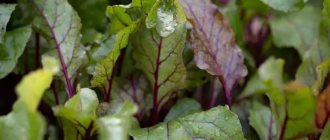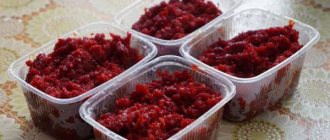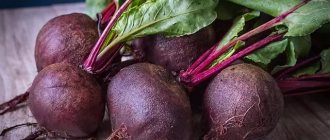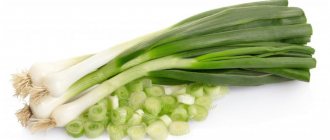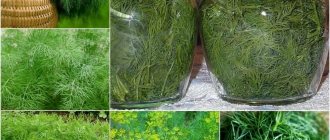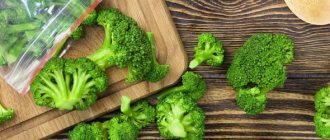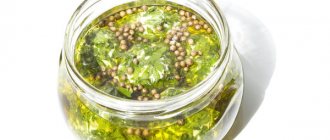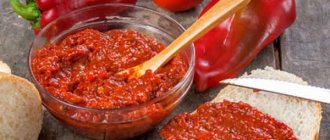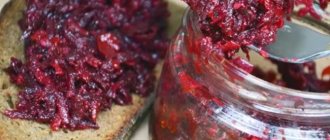Beetroot is a universal food product; both its above-ground and underground parts are used in production. Long ago, only the tops were used for culinary purposes, and the root vegetable was popular exclusively in medicine. Now it’s the other way around: beets are consumed almost every day, but the leaves are out of the ordinary diet and are considered a medicine. Recipes for preparing beet tops for the winter are of interest to many, since this twist is unusual and quite tasty and healthy.
Rules for canning beet tops for the winter in jars
Beet tops contain a number of vitamins and minerals, so many doctors advise using them for the prevention and treatment of many diseases. Before preparing a product for the winter, you need to carefully study the recommendations of experienced housewives:
- Use high-quality, young leaves, as they are softer. If later leaves are used, you can get rid of the hardness by heat treatment.
- The leaves need to be washed well, removed from dirt and sorted, eliminating specimens with visible damage. You should first fill the tops with warm water and leave for a few minutes so that they are better cleaned of debris.
- Cut off about 4 cm at the base of the petiole, as this is where many toxins collect.
Proper preparation of the product is the key to success in subsequent stages of recipe preparation.
Tips and tricks
Take note of a few tips on choosing, storing for future use and preparing dishes from beet tops:
- Try not to buy already cut tops, but take root vegetables with herbs. This way you will receive a product with the most beneficial composition.
- Choose fresh leaves that are bright green and show no signs of wilting.
- Cut the tops 2 cm below the root crop.
- Before use, rinse the sand and soil thoroughly under running water.
- If you plan to store the tops in the refrigerator, do not wash them, just shake off the dirt and put them in a bag. The product spoils quickly, so do not keep it for more than four days.
- Use young leaves fresh. The old ones are suitable for preservation, fermentation and drying.
- Before use, soak large leaf tops in ice water for 10-15 minutes to remove the bitterness caused by oxalic acid.
- To get the maximum benefit, make a smoothie from the tops with the addition of vegetables and fruits.
Pickled beet tops for the winter
Among the many options for recipes for preparations aimed at preserving the taste and benefits of the plant, the most common method is fermentation, since this method preserves the maximum amount of vitamins and other components that have a positive effect on the vital functions of the body.
List of main components:
- 1 kg of tops;
- 30 g garlic;
- 2 dill inflorescences;
- 3 blackcurrant leaves;
- 2 tsp. salt.
Step by step recipe:
- Prepare the main product in advance and chop into small pieces.
- Place layers of leaves, garlic, and dill in a special container for fermentation.
- Lightly sprinkle each layer with salt.
- Place pressure on top and leave at room temperature for 3-4 days.
- Send the workpiece to a cool place for long-term storage.
Calorie content and chemical composition
The chemical composition of the above-ground part of the plant combines a complex of vitamins, as well as an impressive list of micro- and macroelements.
Thus, beet tops can be considered an excellent source of vitamin C (6 mg per 100 g of product). This powerful antioxidant has the ability to increase the body's resistance to viruses and bacteria, making it more resistant to various diseases. In addition, vitamin C is involved in the production of collagen, which helps maintain healthy skin and hair, and is also responsible for the elasticity of blood vessels.
Beet tops also contain vitamin K (400 mcg). It is responsible for blood clotting, and also “cooperates” with calcium and increases the strength of bone tissue, helping to prevent the development of such a serious disease as osteoporosis. In addition, vitamin K prevents the onset and development of Alzheimer's disease, since it prevents the destruction of brain neurons. Moreover, in 100 g of the above-ground part of beets, the content of this vitamin is more than three times higher than the recommended daily intake.
Vitamin A (21 mcg) present in the chemical composition of the product effectively fights free radicals, is used to prevent heart disease, and is necessary to maintain the normal condition of the oral mucosa.
In addition, beet leaves include the entire complex of vitamins B (B6 - 0.2 mg; B1 - 0.05 mg; B3 - 0.7 mg; B2 - 0.04 mg; B9 - 18.6 mg), which influence the metabolic process in the body's cells, promote the normal functioning of the nervous system, help withstand emotional and intellectual stress, and maintain healthy skin and muscles.
In addition, the chemical composition of beet tops contains the most valuable macro- and microelements.
Potassium (239 mg) is an essential component that helps regulate fluid balance in the body, which is important for controlling heart rate and blood pressure. It also helps reduce swelling and improves oxygen supply to the brain.
Chlorine (45 mg) is a substance that stimulates the digestion process, normalizes the blood formula, regulating the red blood cell count, and helps remove excess fluid from the body.
Sodium (20 mg) is involved in the regulation of water-salt metabolism, participates in the production of gastric juice, has a vasodilating effect and helps activate the enzymes of several endocrine glands.
Sulfur (15 mg) takes part in the process of collagen synthesis, which is responsible for the condition of our skin and hair, slows down the aging process, and also has antihistamine properties. Also, without it, the synthesis of hemoglobin, the main component of the blood formula, is impossible.
Phosphorus (34 mg) is a component that takes an active part in energy metabolism, helps strengthen bone and dental tissue, and increases cognitive abilities.
In addition, the chemical composition of beet leaves contains: 814 mcg of aluminum, 134 mcg of copper, 100 mcg of boron, 2 mcg of iodine, 15 mcg of fluorine, 15 mg of calcium, 10 mg of magnesium, 0.5 mg of iron, 0.3 mg of zinc, 0 .22 mg manganese.
Finally, the fiber found in beet greens works as a natural gut scrub. Dietary fiber binds and naturally removes toxins and toxic substances from the body.
As for the calorie content of beet leaves, 100 g of this product contains only 21.1 kcal. The nutritional composition is as follows: no protein, 4.2 g of carbohydrates, and 2.1 g of fat.
Canned beet tops for the winter
Preservation will preserve most of the beneficial qualities of the plant. You can use this product to prepare many delicious and unusual dishes in winter.
Composition of products for creating the blank:
- 650 g tops;
- 1 liter of water;
- 100 ml vinegar;
- 100 g sugar;
- 1 laurel leaf;
- 8 black peppercorns;
- 25 g salt.
Sequence of actions in accordance with the recipe:
- Prepare the main product by cutting into small pieces.
- Place the leaves in a jar.
- Combine water with pepper, bay leaf, salt, add sugar, pour in vinegar.
- Boil the mixture and pour it into jars.
- Close the lid and leave to cool.
Pickling
The use of such preservation is universal. The finished product can serve as a full-fledged side dish or a good addition to salads, main courses and soups.
Output : 1 l
- garlic – 2-3 cloves;
- bay leaf – 1 pc.;
- black pepper – 8-10 peas;
- water – 1 l;
- rock salt – 25 g;
- Place raw materials and spices tightly into prepared jars.
- Boil a brine from water, salt and sugar. Remove the pan from the heat and add vinegar.
- Fill the jars with marinade to the top.
- Roll up the jars with hot lids, turn them over, wrap them and leave until cool.
If you like spicier or spicy marinades, you can add any spices and herbs that are used in canning vegetables to the preparation. If stored in a cool cellar, the product will preserve the benefits and taste of beet tops for 2-2.5 years.
Beet tops, canned for the winter with onions and herbs
You should definitely use the recipe for delicious beet tops for the winter using onions and herbs. Such a bright and summer preparation will be a wonderful addition to any dish.
List of ingredients according to the recipe:
- 650 g beet tops;
- 1 onion;
- 1 liter of water;
- 25 g salt;
- 100 vinegar;
- 75 g sugar;
- 1 laurel leaf;
- greens (dill, parsley);
Sequence of steps according to the recipe:
- Prepare the tops by cutting them into small pieces.
- Combine it with chopped garlic, chopped dill and parsley, and chopped onion into rings.
- Pour salt, sugar, pepper and bay leaf with water, add vinegar and boil.
- Pour the prepared marinade into the jars and close the lid.
Drying and freezing
The aboveground part of the popular culture consists of wide, powerful leaf blades “sitting” on long, succulent stems (petioles). Essentially, these are two different products that can be added to first and second courses, salads and even pie fillings.
Every housewife uses those methods of preparing beet leaves for the winter that correspond to her plans and are suitable for subsequent preparation of dishes loved by family members. The easiest ways to preserve the product are drying and freezing.
When choosing recipes for preparing beet tops for the winter, you must take into account that the leaf blades soften much faster during heat treatment than the petioles. Therefore, they are advised to be prepared and stored separately from each other.
Greens intended for storage are often cut into small pieces, but leaf blades are sometimes frozen entirely: in winter they are used to prepare delicious cabbage rolls, which are in no way inferior to traditional cabbage rolls. Dry the tops in any available way: in the air, in a low-heat oven or a special dryer.
For freezing, the cuttings and leaves are laid out in small portions in plastic bags (tightly, trying to remove excess air). Dried beet greens in a tightly closed container retain their taste and aroma throughout the year; frozen - until the next gardening season.
Preserving beet tops for the winter “five minutes”
The canning process is quite lengthy, but the excellent taste and aroma of the original product will not leave anyone indifferent. The recipe is for one 0.5 liter jar.
Grocery list:
- 200 g root leaves;
- 250 g petioles;
- 1 tsp. salt;
- ½ tsp. Sahara;
- 1 clove of garlic;
- 1 horseradish leaf;
- 1 ml vinegar.
How to make a delicious preparation for the winter according to the recipe:
- Wash the petioles, leaves, horseradish and put them in jars.
- Pass the garlic through a press and add to the main ingredients.
- Combine water with pepper, sugar and salt, add vinegar, and boil.
- Pour into jars, let sit for 5 minutes, drain and bring to a boil again.
- Repeat the procedure three times, finally pour into jars and seal.
Dressing for soup “Pyatiminutka”
This preparation comes in very handy when you need to quickly cook dinner for the whole family, and most importantly, replenish your supply of vitamins during the cold season.
Yield: 1 l (it is better to take jars with a volume of no more than 0.5 l)
Ingredients:
- beet leaves and petioles – 500 g;
- sorrel (leaves) – 300 g;
- dill and parsley (leaves) – 100 g each;
- water – 500 ml;
- rock salt – 1 tbsp. l.
Preparation:
Wash the tops and other greens and chop finely. Boil water and dissolve salt in it. Place the raw material in the brine and boil for 5 minutes. Arrange the greens evenly among pre-sterilized jars.
Add the broth to the containers, filling them to the top. Roll up the jars with hot lids, turn them over, wrap them and leave until cool. The workpiece is stored indoors for 12 months, and in a cool place for up to 2 years.
Recipe for salted beet tops for the winter
The preparation can be used as a dressing for first courses, as a side dish for meat and fish products. The main thing is not to overdo it with salt, since the leaves absorb it well.
Component composition:
- 1 kg of root leaves;
- 1 garlic;
- 2 dill inflorescences;
- 3 black currant leaves;
- 2 tbsp. l. salt;
How to properly create a recipe:
- Prepare the main product by cutting it into small pieces.
- Place in layers in a deep container, alternating with currant leaves and chopped garlic.
- Salt each layer during the process.
- Cover with a wooden lid and press down.
- After three days, place in a cool place for storage.
Video
If you are interested in the topic of the article, we suggest you look at the recommendations of an experienced housewife about drying and freezing beet tops, as well as a television story about its beneficial properties:
Graduated from MGRI named after. Ordzhonikidze. My main specialty is a mining geophysicist, which means a person with an analytical mind and varied interests. I have my own house in the village (accordingly, I have experience in vegetable gardening, horticulture, mushroom growing, as well as fiddling with domestic animals and poultry). Freelancer, a perfectionist and a “borer” regarding his duties. Handmade lover, creator of exclusive jewelry made from stones and beads. A passionate admirer of the written word and a reverent observer of everything that lives and breathes.
Found a mistake? Select the text with the mouse and click:
From varietal tomatoes you can get “your own” seeds for sowing next year (if you really like the variety). But it is useless to do this with hybrids: you will get seeds, but they will carry the hereditary material not of the plant from which they were taken, but of its numerous “ancestors”.
You need to collect medicinal flowers and inflorescences at the very beginning of the flowering period, when the content of nutrients in them is highest. Flowers are supposed to be picked by hand, tearing off the rough stalks. Dry the collected flowers and herbs, scattered in a thin layer, in a cool room at natural temperature without access to direct sunlight.
Humus is rotted manure or bird droppings. It is prepared like this: the manure is piled up in a heap or pile, layered with sawdust, peat and garden soil. The pile is covered with film to stabilize temperature and humidity (this is necessary to increase the activity of microorganisms). The fertilizer “ripens” within 2-5 years, depending on external conditions and the composition of the feedstock. The output is a loose, homogeneous mass with a pleasant smell of fresh earth.
Delicious snack made from beet tops for the winter
Such beet tops for the winter will be an excellent preparation that will look great on a holiday or dinner table as an independent product and an addition to many dishes.
Required components:
- 600 kg root leaves
- 1.5 tsp. salt;
- 60 ml wine vinegar;
- 3 cloves of garlic;
- 3 pcs. sweet pepper.
Important points for preparing the recipe:
- Prepare the main product, cut into pieces.
- Place in sterilized jars, combine with chopped garlic and pepper.
- Salt the workpiece, pour boiling water, add vinegar, close the lid.
Pickling (fermentation)
Most often, not all the tops are salted, but only the petioles, but leaves can also be included in the preparation. The finished product contains all the beneficial substances that the raw materials are rich in, as well as lactic acid formed during the fermentation process.
Salted beet stalks are considered an excellent independent snack and can be used in home cooking as a component of a wide variety of dishes. This is the best option for those housewives who do not like to pickle vegetables and put industrially produced food acids in homemade canned food.
Output: 3 l
- petioles of beet leaves – 1-1.3 kg;
- garlic – 4-5 cloves;
- bay leaf – 2 pcs.;
- black pepper – 10 peas;
- water – 1 l;
- rock salt – 1 tablespoon.
You can add a pod of hot pepper, pieces of horseradish root, dill umbrellas, tarragon sprigs, currant or cherry leaves, as well as any dry spices to taste.
- Wash the beet stems and leaves, pour over boiling water and cut into arbitrary pieces (you can leave them whole).
- Cut the garlic into thin petals.
- Place the tops tightly in a jar, layering it with garlic petals and other seasonings.
- Sprinkle salt on top of the raw material.
- Fill the jar with cold boiled water until it covers the contents.
- Cover with a plastic lid, keep in the cellar for 3 weeks, and then put in the refrigerator.
There is also a faster salting option. It can be done by filling a filled jar with boiling water. In this case, the workpiece is tried after 2-3 days. This product cannot be stored for a long time, but in the refrigerator it is quite capable of lasting for 3-4 weeks.
Preparing beet tops for the winter: a recipe for pickling with garlic and hot pepper
Before you begin the cooking process, you need to study the best recipes for preparing beet tops for the winter. This delicious winter appetizer will be an excellent side dish, as well as an independent dish.
List of ingredients:
- 500 g beet leaves;
- 3 cloves of garlic;
- 1.5 tbsp. l. salt;
- 6 tbsp. l. vinegar;
- 1500 ml water.
The cooking recipe includes the following processes:
- Prepare the main ingredient, grind it, rinse the jars with hot water or sterilize.
- Place the leaves in a jar, place chopped garlic and finely chopped pepper on top.
- Boil water with salt, pour in the contents of the jar, add vinegar.
- Close with lids and leave to cool.
Preparing the main ingredients
For salads and fresh use of tops, it is recommended to collect early leaves, as they become tough during the harvest period. The workpiece can also be made from late tops, but in order to soften it, heat treatment is carried out. For harvesting, choose cloudy weather without rain. If the vegetables were fed with nitrates, then it is necessary to cut off 5 centimeters of the cuttings at the base, this is where their accumulation is observed.
After collection, the leaves are thoroughly washed, excess debris and greens with obvious signs of damage are removed. To make the process easier, you can put the tops in a bowl of water for a couple of minutes; all small specks and light foreign objects will float up, so they can be easily removed.
Pickled beet stalks for the winter
You can pickle not only the leaves, but also the petioles. This preparation is suitable for cooking borscht, and also as a decoration for main courses.
Ingredients and proportions of the workpiece:
- 600 g beet stalks;
- 250 ml vinegar;
- 2 liters of water;
- 5 carnations;
- 5 allspice peas;
- 5 g horseradish root;
- 2 laurel leaves;
- 100 g sugar;
- 40 g salt.
Recipe for making preparations for the winter:
- Prepare the main ingredient and cut into pieces, put in jars.
- Peel and trim the root, combine with chopped cloves, pepper and bay leaf.
- Pour the spice mixture with water, add salt, sweeten, add vinegar, and boil.
- Keep for 5 minutes, pack into jars, roll up.
Beet stalks marinated with garlic and dill
Garlic and herbs will give the dish an amazing aroma and attractive taste. This preparation will be stored for a long time without losing its beneficial properties.
List of components:
- 500 g beet petioles;
- 200 ml vinegar;
- 1.5 liters of water;
- 60 g sugar;
- 20 g salt;
- greenery.
Step-by-step recipe for preparing food for the winter:
- Cut the main product into medium-sized pieces.
- Place in a jar and place crushed garlic and herbs on top.
- Combine all other ingredients and boil, do not remove from heat, for another 5 minutes.
- Pour into jars and close with a lid.
Storage options
The following methods help preserve beet tops for the winter:
Heat treatment slightly reduces the amount of vitamins and minerals. Freshly frozen, dried and pickled tops are considered the most useful.
Leaves pickled in vinegar keep in the pantry for a long time. They are used as a savory addition to meat, fish, cereals and vegetables.
Pickling
You can pickle both leaves and petioles of beets, but their processing will be different.
The petioles are prepared using the triple-pouring method: the hot marinade is poured, drained, boiled and re-poured three times.
The leaves are prepared by sterilization: the hot marinade is poured into jars and boiled for 5 minutes. Cover the blanks with lids, turn them over and wrap them in a blanket.
Drying
Beet leaves contain practically no essential oils, so they can be dried immediately after cutting. For this purpose, use an oven, dehydrator or electric dryer. Drying temperature – no more than 60°C.
Dried tops are used in folk medicine to treat constipation, headaches and mastitis.
Pickling
Beet tops, fermented without vinegar, have a wonderful taste and a lot of useful properties. Moreover, its chemical composition multiplies several times. It can be stored for a long time and not spoil. Fermented foods speed up metabolism and the digestion process by normalizing intestinal microflora.
Pickled beet leaves
This preparation is perfect for preparing first courses, salads, and can also be used as an independent product. To prepare it, you should stock up on the following set of components:
- 500 g beet leaves;
- 1 laurel leaf;
- 1 small garlic;
- 3 cloves;
- 1 dill inflorescence;
- 7 black peppercorns;
- 100 ml vinegar;
- 3 tbsp. l. Sahara;
- 1 tbsp. l. salt.
Procedure according to the recipe:
- Wash the leaves and cut into small pieces.
- Place cloves of garlic, spices and herbs at the bottom of the jar, compact the leaves.
- Combine salt, boil sugar and water and pour into jars, add vinegar.
- Close the lid and let cool.
Preparing the main ingredients
For salads and fresh use of tops, it is recommended to collect early leaves, as they become tough during the harvest period. The workpiece can also be made from late tops, but in order to soften it, heat treatment is carried out. For harvesting, choose cloudy weather without rain. If the vegetables were fed with nitrates, then it is necessary to cut off 5 centimeters of the cuttings at the base, this is where their accumulation is observed.
After collection, the leaves are thoroughly washed, excess debris and greens with obvious signs of damage are removed. To make the process easier, you can put the tops in a bowl of water for a couple of minutes; all small specks and light foreign objects will float up, so they can be easily removed.
How to prepare beet tops for the winter: freezing
Many housewives do not have the opportunity to spend a lot of time at the stove, but they want to prepare such a tasty and healthy product as beet tops for the winter. In this case, you can simply freeze it. By resorting to this method, you can preserve the maximum of useful vitamins and microelements, as well as the taste of the product. Tops are frozen in several ways. Most often, it is doused with boiling water, placed in plastic bags and sent to the freezer. This procedure is carried out quickly and allows you to prepare a large amount of raw materials. You can also use a plastic container instead of a bag.
For first courses, it will be more convenient to freeze the product in the form of cubes and mix with dill and parsley for convenience.
Preparing the main ingredients
Beet leaves play an invaluable role in traditional medicine. And special benefits are observed precisely in foliage freshly picked from the garden bed.
Eating these greens from May to September can significantly improve the functioning of the immune system.
But it’s not only the fresh product that is beneficial. Preparing tops for winter using various methods allows you to pamper your body with vitamins all year round.
The simplest method is freezing beet tops, which requires the following preparation:
- It is necessary to use only fresh leaves, which are extremely undesirable to store in the refrigerator beforehand, since at this time a significant part of the useful components is wasted.
- It is also worth paying attention to the fact that it is necessary to cut off the tops near the soil, along with the petioles, as this encourages new leaves to grow. By the way, it is better to collect leaves for harvesting in the early morning, in cloudy weather conditions.
- After collecting the plant, it is necessary to process it very carefully: rinse it generously in cold water, and carefully wipe each leaf with your hands. Trim the bottom of the petiole (about 3 centimeters).
- And then, for ease of storage, chop the prepared tops with a knife.
Beet tops can also be mixed with salt. First, it must be thoroughly washed, allowed to dry thoroughly, sprinkled with plenty of salt and placed in glass jars as tightly as possible. Shelf life: at least six months in the refrigerator.
Note! To prepare plants for winter, you can use methods such as fermentation and pickling. This method does not always allow you to preserve useful components in the product, but it is perfect as a tasty addition to many dishes.
Is it possible to dry beet tops?
Drying tops is one of the best ways to prepare a product, the main advantage of which is the preservation of 98% of the nutrients. This indicator cannot be achieved by any other method.
How to dry beet tops for the winter
The beet tops must be washed, soaked for a few minutes and dried on a towel. Place the workpiece in a sunny place in one layer and leave for several days. You need to check and turn the product every day.
To speed up the process, you can spread it on a baking sheet and put it in the oven. Keep it there until the leaves begin to shred when pressed.
How to properly store workpieces
Rules for storing beet tops depend on the harvesting method:
- Pickled and canned ones are kept in the refrigerator or cellar.
- The dried ones are placed in paper bags or linen bags and hidden in a dark place.
- Frozen leaves are stored at temperatures from -5°C to -20°C. The lower the temperature, the longer the shelf life, on average 10 months.
- Tops pickled with vinegar are stored in the pantry or taken to the basement for safety.
